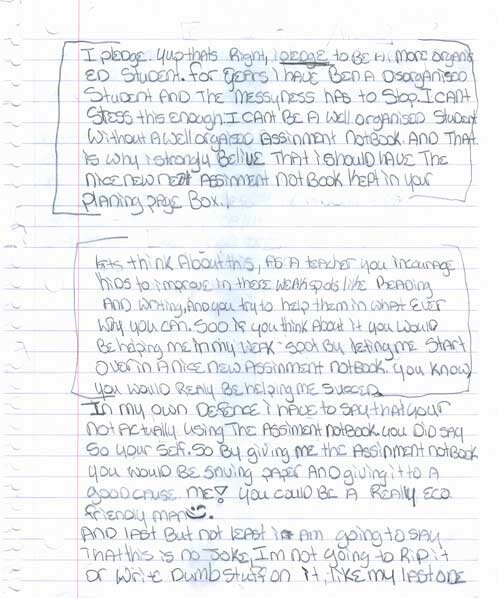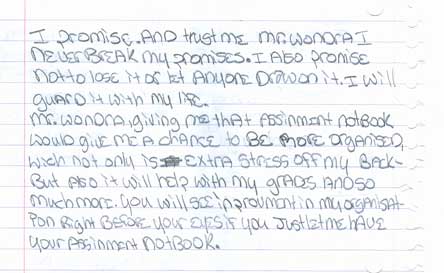Teaching Writing From 30,000 Feet
Good writing is good thinking.
Well written is well thought out–which is to say that it’s well planned, well organized, speaks to an audience, has a clear and unique voice and just the right words strung together in just the right way to have just the desired effect.
One of the challenges in teaching writing is helping students to internalize what all that actually looks like. Change one variable–your audience, your purpose, the topic, even the media–and your target shifts. Writing is a complex task requiring the management of multiple variables, strategies, and processes.
A blank page means anything is possible. As writing teachers, we need to narrow that down a bit–quite a bit.
A blank page means anything is possible. As writing teachers, we need to narrow that down a bit–quite a bit.
Teaching Writing on the Ground
The bottom line, of course, is that we want our students to become better writers. As we get closer to the actual meat and potatoes of the process (instruction and assessment), the choices we need to make, though many, become clearer:
- What type of writing are we going to focus on (this time)?
- What media will we be using?
- Who is our intended audience?
- What is the prompt?
- Is this something that involves research?
- What are the elements we want to see in the piece?
- How often will students “produce.”
- How will I provide timely and meaningful feedback?
These are just a sampling of the “instructional design” choices a teacher has to make. And they’re vitally important, because you always want to get the most bang for your buck. You always want to design the most effective instructional plan. And then, when it’s all said and done, somehow, you always want to cement new learning with some type of reinforcement–so that it sticks.
That’s what I want to show you today: a way to pour cement so that we might firm up the foundation of new learning you’ve established in your instruction.
Relevance: The Rubber on the Road
At this stage in my development, I’d have to argue that good writing instruction includes what I’ll call a range of relevance. What I mean is, from a student’s perspective, some assignments (read practice) are more real and some less real. In other words, we aren’t publishing everything. We aren’t actually sending every letter, or submitting every opinion piece to our local paper–nor do we want too.
To write and share our ideas with a real audience, for a real purpose, is what we’re working toward. It’s the game day for which we’ve been preparing.
So, what that means is: We Need Game Days!
And I would argue that, once we’ve reached a certain level of writing–we need them as often as we can get them. There is a reason writing is such a valuable skill. And it’s not to impress a teacher.
So how do we do that? How do we consistently create unique, meaningful, relevant writing opportunities for individual students–without completely losing our minds? Because, let’s be honest–this can be a lot of work.
I would argue. . . let them argue. I’ve written about this before.
Most often, the most relevant writing tasks are not graded assignments, but opportunities that spontaneously present themselves–you just need to be able to recognize them. How? Here’s a tip: They almost always center around something a student wants (or does not want).
Like:
- A detention
- A field trip
- A grade
- A due date (for an assignment)
- An assignment
- A point or points on a particular test, quiz, project, or assignment
- The ability to choose (a partner, an assignment, a due date, some element of a project)
- The right/privilege to eat or drink or chew gum in class
- The right/privilege to listen to music
- To go outside
- The list goes on and on!
The key here is that students MUST have the ability to actually create change with their writing. I strongly caution teachers against merely pretending that students have some control. This is not a semi-relevant prompt in which only the problem is real.
And therein lies the second key. The student must produce quality writing–in whatever form and at whatever level of expectation you’ve already established.
Do that–only go half way–and we’re shooting ourselves in the foot. Part of the opportunity here is to show students the very real power of quality writing. And therein lies the second key. The student must produce quality writing in whatever form and at whatever level of expectation you’ve already established.
As writing teachers, we know we have a problem when it comes to skill transfer. Students will write well in a Language Arts, English, or Writing class–but ask them to produce a quality lab summary for Science and it all falls apart.
The piece itself–or I should say, the reason for the piece–may have nothing to do with your class. In short, we are demanding transfer of skills. But, again, in order to pull this off, quality must be king.
I’ll close here with an example.
At the beginning of the year, we supply each of our Middle School students with a planner. Recently, a girl in my class came to me with a request. She’d lost her planner, and she knew I had a spare.
Initially, her approach was to make a verbal plea. Bingo. This was my chance to create an opportunity for her to reinforce what she’d already learned about persuasive writing.
I told her that I would consider giving her my extra planner if she was able to produce a persuasive essay convincing me to to do so.
Below, is her actual handwritten essay (and below that, because it might be hard to read, I’ve supplied a typed version).
Please keep in mind that I offer this up, not so much as an example of quality (there’s plenty of room for improvement here as you will see), but as just one example of an almost limitless number of simple, yet very relevant opportunities to reinforce the elements of quality writing that you’ve established in your instruction.
I think it’s a great supplement to an already rigorous instructional plan. And on top of that, it’s always fun to read what students will create when it really counts.
I pledge, yup that’s right, pledge to be a more organized student. For years I have been a disorganized student and the messiness has to stop. I can’t stress this enough. I can’t be a well organized student without a well organized assignment notebook. And that is why I strongly believe that I should have the nice new neat assignment notebook kept in your planning page box.
Let’s think about this. As a teacher, you encourage kids to improve in there weak spots, like reading and writing , and you try to help them in whatever way you can. So if you think about it, you would be helping me in my weak spot by letting me start over in a nice new assignment notebook. You know, you would really be helping me succeed.
In my own defense, I have to say that you’re not actually using the assignment notebook. You did say so yourself. So by giving me the assignment notebook, you would be saving paper and giving it to a good cause. ME! You could be a really eco friendly man.
And last but not least, I am going to say that this is no joke. I’m not going to rip it or write dumb stuff on it, like my last one. I promise. And trust me, Mr. Wondra, I never break my promises. I also promise not to lose it or let anyone draw on it. I will guard it with my life.
Mr. Wondra, giving me that assignment notebook would give me a chance to be more organized, which not only is extra stress off my back, but also it will help with my grades and so much more. You will see improvement in my organization right before your eyes if you just let me have your assignment notebook.










Getting ready to start a persuasive piece with a third grade class. Really excited! Persuasive pieces are so much a part of the Common Core Standards and SHOULD be!